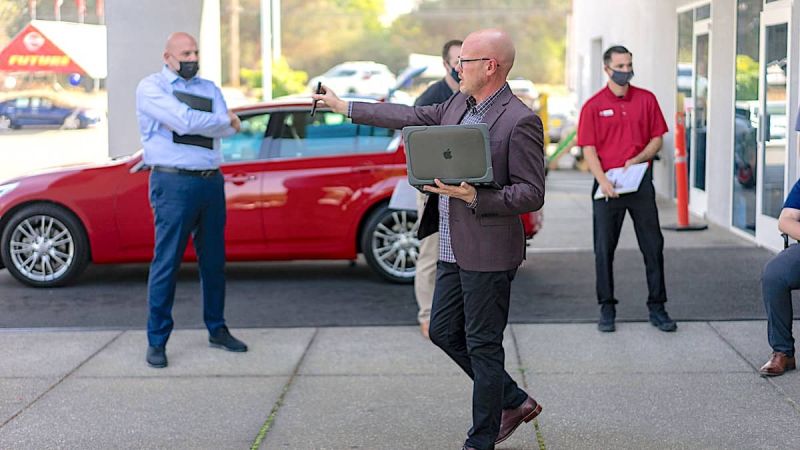After the Research, Have a Negotiation Plan
Buying a new car is both an enjoyable event and a stressful one. It’s time for a new car to replace the old one that is now more repair than it is reward; you’ve calculated your budget so that you know what your absolute upper limit is toward buying a car; and, you’ve done your research and you are ready to go and face the salesman at a dealership. Right? Well…almost.
As it turns out, you also need to know how to take control of the conversation you will have with a salesman by keeping a “first-things-first” focus that will derail any attempts he or she may make to confuse you with the numbers toward the purchase of a new car. In other words, be prepared with a negotiation plan---and stick to it.
According to a recent Consumer Reports recommendation on buying a new car at a dealership, you can level the playing field by starting the negotiations with your pre-calculated low offer and keeping the focus on the offer, while avoiding getting sidetracked with conversations veering off into trade-in values, rebates, and financing---all of which are sales tactics to confuse the potential buyer and benefit the dealership.
When you start bargaining, CR recommends working from your positions of strength that (since you have already done your research) include:
• Your opening bid, based on what you’ve determined the dealer likely paid for the vehicle and/or what you’ve determined is a fair price.
• A portfolio with printouts containing the facts on the model you are interested in, including competing prices from other local dealerships; and, facts from car-buying websites that will reveal what customers have recently paid for the model(s) you are interested in.
In Case You Haven’t Done Your Research
While you may know exactly what vehicle you are interested in, there’s more to the research than just knowing a car’s specs and features and what the MSRP sticker says about the car in the lot.
At the very least, you will need to have your opening bid determined before entering the dealership. And, the easiest and best way to do that is to visit sites like the car category of Consumer Reports and look for the webpage headings “Cars: Start Your Research Here” and enter into the fields the make, model and year of vehicle you are interested in. Also, go to sites such as this one for the latest news of new car deals as they surface.
From there, you can choose among a number of subheadings that includes useful information such as ratings, road tests, reliability, etc. However, the one you will want at this point is the “View Pricing Information” header which will take you to a webpage where you will find not only the MSRP (without a scamming bump sticker attached to it), but more importantly---how much other buyers of the model have paid in your state for the same or similar model within the past month.
An added feature of this page is that it will give you a breakdown of how prices ranged from excellent to high---including the possible reason(s) for selling price discrepancies within the same model between different dealerships where the vehicles were sold. This is useful information because it can give you a clearer idea of where you and the dealer may currently fit within the scheme of new car sales and selling.
An Addendum: I would also recommend that if possible, to scope out the dealership’s parking lot ahead of time to see their selection of the model you are interested in. Knowing that they might not have the exact color or other feature you prefer beforehand in their lot, can increase your bargaining power and avoid being sidetracked into something else that they “just happen to have on their lot right now.” In other words, the salesperson may push for an alternative (and more expensive) trim model saying it is available, but the one you want is not available (or is hidden from view).
Negotiate With Knowledge
Now that we’ve determined that you have a predetermined opening bid and your research is physically in your hands to support your negotiating, now is the time to go the salesperson. Here are the key points you will want to follow as the negotiation process begins before he or she starts talking about prices, rebates, deals, financing, or whatever else may be in their sales pitch:
1. Be upfront with the salesperson---let him know what you know to include that you have:
• Test driven the vehicle or not.
• Researched the specs and features of the model you are looking for.
• Have specific trim and other options in the model that you are looking for.
• Know what the MSRP of the vehicle is and that your research also shows past purchases in the area within the past month.
• An idea of approximately what the dealer paid for the vehicle.
• Calculated a target price that you have determined is fair for both parties.
2. Keep the focus on the target price---which you should have already set for yourself with a low-end and an upper-end. Start with the low end of course, but be willing to show some indication of flexibility. The salesperson may counter back with what the actual invoice price the dealership paid (which is likely inflated), but let him know that it’s the transaction price (as printed out in your research) you see as what is meaningful and relevant to the negotiation.
3. Be prepared for the sales tactics---which are intended to sidetrack your focus and wear you down. Be prepared to spend much of the negotiating process waiting for the salesperson as he or she goes back and forth between you and their manager. Rather than accepting a manager’s offer, counter back with a little increase in your target price to feel out whether they have exhausted all of their bargaining features. Do not let them detour you into calculating your old car’s trade-in value, rebates or other distractions.
4. Deal or No Deal---at some point you are going to begin to see that the back and forth is tiresome and not getting either of you anywhere. Now is the right time to pull out your trump cards and lay them before the salesperson. These cards can include, but are not limited to:
• Telling the salesperson that if you can both agree to terms you know to be fair, they can look forward to making a quick sale immediately. If not, you’ll move on.
• Mention or show that you have competitive bids in hand from other dealers for the same vehicle.
• If the negotiations are going nowhere, this is the time to excuse yourself and get up to leave. At this point, they will either let you go or will reveal their true final negotiating price. If it’s within your target and better than that you believe you can find elsewhere, it’s time to close on the buying price and have them intitial beside the agreeing number on a printout of the vehicle sales sheet. If they do not come after you, be prepared to walk away---which is fine; There are other cars and other dealerships, and it is not unheard of for a salesman to call back the next day with a more attractive offer.
Finishing the Purchase
Once you and the dealer have settled on an amicable price for the new car, now is the time to get into separate discussions about what trade-in value the dealership will offer for your car and what financing you have in mind. The reason for not allowing these discussions earlier is that in reality both are your bargaining chips to use when you choose---not when the dealer chooses.
As part of your earlier research, you will know the transaction value of your used car and can insist that the dealership should give you at least its wholesale value as a trade-in allowance. While the salesperson may whip out a Blue Book value, show him your research that shows what buyers are currently paying for specific models of used cars for your best value.
If it is unaccepted and you cannot come to a compromise, you can always sell your old used car yourself and make out better afterward. You can also argue that the trade-in allowance is a deal breaker for you---now that the dealership has previously agreed to your transaction price. It seems like hardball---and it is---but rest assured no dealership is going to end up with a loss in the end. They just want you to feel that way.
Financing can be treated the same way. Again, it is your bargaining chip and you should be prepared by having first checked with your bank and other lending institutions to see who offers the better deal and have it ready to show in your car buying portfolio.
Take Home Messages
This was a lot of information; however, if you follow the main message (aside from doing your homework) it is that you should guide the negotiations by keeping the focus on your target price. Sticking to your target price range will not only get you a better deal, but will also alleviate a lot of the stress of dealing with a car salesman when buying a new car and avoid buyer’s regret afterward.
For more details about how to negotiate your new car purchase with a car salesman, I encourage you to check out the Consumer Reports website for additional info and recommended practices toward buying a car.
Looking to buy a car right now? Here's the latest on the most discounted cars available today.
COMING UP NEXT: How to Inspect The Transmission Fluid on a Used Prius
Timothy Boyer is Torque News Tesla and EV reporter based in Cincinnati. Experienced with early car restorations, he regularly restores older vehicles with engine modifications for improved performance. Follow Tim on Twitter at @TimBoyerWrites for daily Tesla and electric vehicle news.
Photo by Clayton Cardinalli on Unsplash











